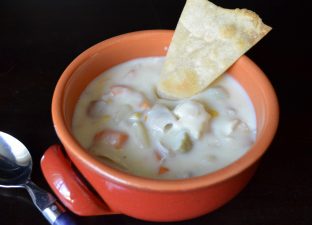Are you new to living gluten free? |
Here you'll discover all the tricks and tips I've learned from years of gluten free living, all in one convieniet place so you can
cook better, feel better, live better.
You’ve just been told that you have celiac disease.
Naturally you feel overwhelmed at the prospect of changing how you eat – and maybe a bit insulted that you even have to! Are you doomed to a life of Deprivation while everyone around you gets to eat all the good stuff?
Absolutely not!
Right now you’re confused and frustrated, but all you really need to do is stop for a moment and take a deep breath.
Ready? Close your eyes…breathe in…hold for a moment…and breathe out…
Now, let’s get started on your new – wonderful – way of life!
Direct from my kitchen to yours, you'll find...
Food so tasty you’ll never think you’re on a “special diet”…
Meals that are not only satisfying, but will save you money on groceries…
Sources and secrets that answer all your questions about attaining gluten freedom.
All you have to do is follow along – my easy gluten free recipes are tested and tried on celiacs and non-celiacs alike. If someone doesn’t ask for the recipe, it doesn’t pass my taste test!
And wait until you see how easy and affordable it is to cook gluten free at home without expensive “convenience” products that taste like sawdust.

I’m Kathy, founder of Your Gluten Free Kitchen
and I’m on the same journey you are
– the journey of living gluten free.
Click on a topic below to get started:
Celiac disease is a problem some people have with foods that contain gluten. Gluten is a kind of protein found in wheat based foods like bread, crackers, and pasta. With celiac disease, your immune system attacks the gluten and harms your small intestine when you eat these kinds of foods.
When people with celiac disease eat foods or use products containing gluten, their immune system responds by damaging or destroying villi—the tiny, fingerlike protrusions lining the small intestine. Villi normally allow nutrients from food to be absorbed through the walls of the small intestine into the bloodstream. Without healthy villi, a person becomes malnourished, no matter how much food one eats.
Celiac disease is also known as celiac sprue, nontropical sprue, and gluten-sensitive enteropathy. Celiac disease is genetic, meaning it runs in families. Sometimes the disease is triggered—or becomes active for the first time—after surgery, pregnancy, childbirth, viral infection, or severe emotional stress, to name a few.
WHAT ARE THE SYMPTOMS?
Symptoms of celiac disease include:
- unexplained iron-deficiency anemia
- fatigue
- bone or joint pain
- arthritis
- bone loss or osteoporosis
- depression or anxiety
- tingling numbness in the hands and feet
- seizures
- missed menstrual periods
- infertility or recurrent miscarriage
- canker sores inside the mouth
- an itchy skin rash called dermatitis herpetiformis
- digestive symptoms
People with celiac disease may have no symptoms but can still develop complications of the disease over time. Long-term complications include malnutrition—which can lead to anemia, osteoporosis, and miscarriage, among other problems—liver diseases, and cancers of the intestine.
HOW IS CELIAC DISEASE DIAGNOSED?
Your doctor will ask questions about your symptoms and do a physical exam.. You may have blood tests to see if you have certain antibodies that could mean you have the disease. To make sure you have celiac disease, you will probably have an endoscopy. In this test, a doctor uses an endoscope-a thin, lighted tube that bends-to look at the inside of your small intestine. During the endoscopy, the doctor may take small samples of tissue to be tested in a lab. This is called a biopsy.
Often celiac disease is mistaken for another problem such as food intolerance or irritable bowel syndrome. You may be treated for one of these problems first.
After your celiac disease diagnosis, your doctor may do more tests, such as blood tests to check for anemia or a bone density exam. These will help your doctor find out if you have other problems, such as osteoporosis, that can arise when you have celiac disease.
HOW IS IT TREATED?
To get and stay well, you need to avoid all foods that have gluten. Do not eat any foods made with wheat, rye, barley, or triticale. Don’t drink any beer or ale.
You can still eat eggs, meat, fish, fruit, and vegetables. Flours and starches made from rice, corn, buckwheat, potatoes, and soybeans are also okay. Within 2 weeks after starting a gluten-free eating plan, most people find that their symptoms have improved.
NEW FOOD LABELING
The Food Allergen Labeling and Consumer Protection Act (FALCPA), which took effect on January 1, 2006, requires food labels to clearly identify wheat and other common food allergens in the list of ingredients. FALCPA also requires the U.S. Food and Drug Administration to develop and finalize rules for the use of the term “gluten free” on product labels.
*Information from WebMD.com and US department of Health and Human Services
Cooking is part science and art. And even more so when you are dealing with allergies to foods that are an integral part of recipe. Take wheat for instance. Once you convert over 100’s of recipes to gluten free, it becomes pretty easy. I can look at a recipe now and tell you exactly how to change it and I’m usually pretty close.
But, I can eat eggs and consume dairy. Addressing recipes where you have to remove the dairy, wheat and the eggs becomes quite the challenge. A few things will lend themselves well to that, but almost all baking uses dairy and eggs as the backbone of the recipe.
The following substitutions should help you to start experimenting with the recipes on this website, as well as your favorites.
Most of us are blessed with well stocked grocery stores and for that I am thankful. Food companies are taking up the baton and coming out with more alternatives for those of us with allergies every day. Finding products we can use is becoming easier.
No Dairy:
Try these for a milk alternative:
Soy milk, rice milk, nut milks, coconut milk, fruit juices, water, tea, coffee, soft drinks, lemonade.
One note: don’t bother to buy the lite coconut milk. It is regular coconut milk that has been watered down half and half. Why buy more water for the same price! If you want “lite” coconut milk, buy the regular kind and dilute it yourself.
To substitute for butter:
Non-dairy margarines, organic butter-flavored shortening, coconut oil, organic shortening
Look for recipes that use oil as the fat in them instead of butter. I would start a large collection of these.
To substitute for cream:
Try using the non-dairy creamers on the market. Soy creamers are also available. You can whip chilled coconut milk for a whipped cream substitute (add a little gelatin to help it hold its shape).
To substitute for cream cheese and sour cream:
The soy based cream cheese and sour creams are very good. I cannot tell any difference between them and the real thing.
Silken tofu also makes a good sour cream alternative.
To substitute for buttermilk:
Add to 1 cup of the alternative milk of your choice 1 tsp of vinegar or 1 tsp of lemon juice. Allow to sit for about 5 minutes so it has time to curdle. I think this is cheaper than using soy yogurt or soy sour cream as a replacement.
To substitute for ice cream:
I would invest in a countertop ice cream maker. Use coconut milk as a base. You may need to add some xanthan gum to help it hold together better. I would keep the amount small, 1/4 tsp to start, and see how that works. Even if it turns out soft, as long as it tastes, good no one will care. If you check the labels on ice cream you will see xanthan gum used in the lower calorie versions. Interesting, huh!
I would also try making frozen yogurt. It will be cheaper to make your own if you eat it a lot.
Make a lot of fruit sorbets! They are as refreshing as they are good for you. You can use any heavy duty blender to make them. Fuss free and fat free.
No Eggs:
Note: use these substitutes in recipes that call for no more than 2 eggs. If the recipe for cake or cookies or pie call for more than that, try to find one that makes a smaller version of the same thing or similar.
Egg-Replacer is available at most grocery stores.
You can make your own “egg-replacer” using Flax meal. To 1 Tbsp. of flax meal mix in 3 Tbsp. of hot water. Let it set up for about 5 minutes before using. Use this to replace one egg. You can make a larger batch and keep it in the refrigerator for up to one week. Use 1/4 cup per egg called for in a recipe.
You can use 3 Tbsp. of unsweetened applesauce mixed with a tsp of baking powder.
To substitute for scrambled or hard cooked eggs:
Use Firm Tofu, cut into small cubes and cook to warm. Add seasonings to taste.
To substitute for an egg wash:
Use milk, or cream when an egg wash is called for. It will not give the “shine” an egg wash does, but it will allow you to sprinkle on seeds or sugar and have them stick.
You have been diagnosed with celiac or suspect that gluten may be causing you problems. You have scoured your house, reading label after label, throwing out anything that could be a potential threat to your health.
Everything has been washed and cleaned and re-organized. You have made the journey to a natural foods store and loaded up your cart with gluten free goodies.
You look around you and are sure you have done everything you can to safeguard your health and well-being...
BUT HAVE YOU?
Right now, there are culprits lurking within your home ready and able to sabotage your efforts to keep yourself gluten free!
Where are they hiding? Some are right out in the open on your kitchen counter. Some have taken up residence inside your refrigerator. Others are hiding in your local grocery store.
One of the most often overlooked areas to gluten free living is the problem of Cross Contamination!
Small kitchen appliances:
are a major factor that contributes to cross contamination. Your toaster is hoarding small bits of bread every time someone in your house makes toast. If you live with gluten eating members, this can be a real problem! It is impossible to get every speck of bread crumbs removed from your toaster just so you can use it!
Do what I do, buy a toaster just for yourself. Who has the time to clean out your family toaster after everyone uses it? Not me and I’m sure you don’t either. Toasters are very inexpensive insurance for your health and peace of mind.
Other small appliances also need to be purchased in pairs. Your waffle iron harbors gluten crumbs, along with sandwich makers and Panini presses. If you cannot wash your kitchen appliance with soap and water or if it cannot be placed in the dishwasher, you will need to have two of them. Make your own “For Gluten Free Foods Only” labels and attach them to any small kitchen appliance that you are dedicating to gluten free cooking. Make sure everyone knows that these are off limits for anything that contains gluten.
Let’s look inside your refrigerator next:
Let’s see! Lots of interesting things in there. I see butter, margarine, mayonnaise, jellies and jams, mustard. How long has that jar of relish been in there? What do all these things have in common besides taking up space in your frig. They contain small bits of gluten in each and every one of them. Every time someone makes a sandwich or spreads their toast with butter and jam, gluten crumbs go along for the ride and embed themselves into the spread.
It will be necessary for you to have all your own jars of condiments and spreads that are used in your household for sandwich making or toast or anything else that requires a utensil to transfer it to food that is made with gluten. Every time someone dips that knife into the jar, gluten crumbs are transferred over.
Make some more “for Gluten Free Foods Only” labels for your own bread spreads. This is a great opportunity for you to buy what YOU really like! Go ahead and get that jar of marmalade that no one else will eat but you. Splurge a little and buy some fun spreads! Corral all your spreads in a small plastic box container that you can put in your refrigerator. Having them all in one place and contained will make it easier for you to find and harder for the gluten eaters in your group to grab the wrong jar! Make it easy on them and you!
A word about oats:
Oats in and of themselves do not contain gluten. The reason they have been prohibited for celiac is that they are often grown next to fields of wheat or barley. Seeds often cross between the fields and at harvest time the wheat is taken in and then the oats right after it. They are often cross-contaminated not only in the field but also during processing. Therefore, the oats in the store have been deemed off limits.
Now for the good news!
Farmers have stepped up and taken the challenge of growing oats and implementing processing procedures to ensure that there is no cross-contamination! They are more expensive than the store ones (isn’t everything we buy) but it’s great to be able to have a bowl of oatmeal or spicy oatmeal raisin cookies again. As with everything, check with your doctor to make sure you can have gluten free oats.
Now, let’s turn our attention to your local grocery store.
Beware the Bulk Bin Aisle:
There is no guarantee that your fellow shoppers have used the scoop that was for the rice but instead dipped it into the wheat flour bin two buckets down. Once a bin bucket has become empty, there is no way you can tell if the same bulk item was placed in that bucket every time. It may have contained wheat berries, rye flour, barley flour or any number of things before the rice was placed in it. Don’t take a chance. Skip this section and buy grains and flours in packages that state the product is gluten free!
Let’s belly up to the Deli Counter Bar next:
Most stores incorporate their hot food items in the same space and counter area as their deli meats and cheese slicing section. The deli employee may have just pulled out a bunch of crunchy chicken fingers just before they have taken your order for sliced meats. Be careful here and diligent. Watch how things are handled. The same people may not be working in both sections at the same time making cross contamination less of a problem. Always ask for label ingredients in your deli meats and cheeses.
All Boar’s Head brand meats and cheeses are labeled gluten free. This includes their brand of hot dogs, sausages, and many of their relishes. I have purchased them often and can tell you that they are fantastic!
Be proactive with your new lifestyle! Information is power when it comes to gluten free! Make sure to keep learning all you can about gluten free living!
You don't need to do this alone... Supports Groups for Gluten Intolerance.
Make sure your join up with your local group. You can meet up with people you are leading the same lifestyle you are, find out what their favorite restaurants are, go to meetings, make new friends, share recipes and keep up to date on what’s new in the gluten free community.
Join one today!
Cecliac Sprue Assocation
Celiac Sprue Association
P.O. Box 31700
Omaha, NE 68131
Telephone: 877-272-4272
e-mail: ce*****@cs********.org
www.csaceliacs.org
Celiac Disease Foundation
Celiac Disease Foundation
13251 Ventura Boulevard, Suite 1
Studio City, CA 91604
Telephone: 818-990-2354
e-mail: cd*@ce****.org
www.celiac.orgGluten
Gluten Intolerance Group of North America
Gluten Intolerance Group of North America
31214 124th Ave. SE
Auburn, WA 98092-3667
Telephone: 253-833-6655
e-mail: in**@gl****.net
www.gluten.net
Ready for more?

The Kitchen: A gathering place for friends and family. A place where memories are homemade and seasoned with love.
God bless, Kathy - Your Gluten Free Kitchen




